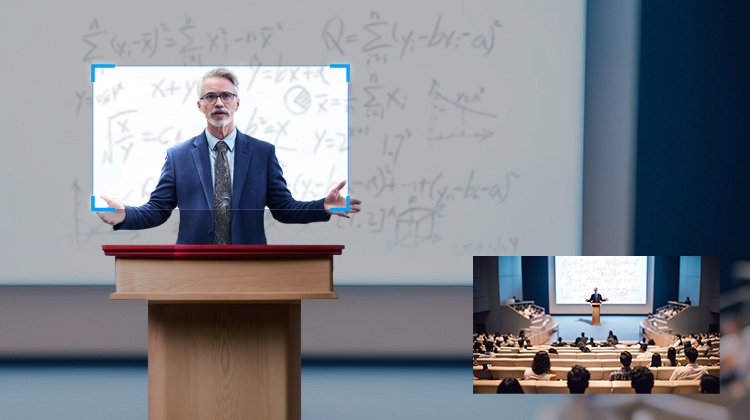Dual lens cameras are changing how professional events and lectures are recorded. And with a projected 100 billion in pro AV spending over the next several years, this technology will only become more widespread.
But how is dual lens technology different from other cameras? And how can these cameras be best deployed for professional events, performances, HyFlex teaching, or higher education lectures?
In this article, we’ll go over dual lens cameras, what they are, and how they can be deployed for Pro AV purposes.
What is a Dual Lens Camera?
Like its namesake, a dual lens camera uses two lenses for streaming. You might be familiar with dual lenses for smartphones or security cameras, in which both lenses are used for stereopsis. However, two lenses in PTZ cameras can be deployed differently.
A dual lens camera for Pro AV houses one lens as an auto-tracking camera and another lens as a wide-angle camera. The auto-tracking lens can closely follow subjects within the frame and capture details like a typical PTZ camera, while the wide-angle lens supports capturing the entire background or stage simultaneously.
What Are the Advantages of Pro AV Dual Lens Cameras?

- Wide Angle Views: Dual lens cameras can capture a much larger field of view. This wide angle can stream the full space with precision while also maintaining a superb tracking ability.
- Automatic PTZ: The PTZ camera on top can automatically pan, tilt, or zoom in on a designated subject. By using these automated features like in the AVer TR535/TR535N, users don’t have to constantly adjust settings during a video stream.
- Automatic Tracking: Dual lens cameras also have the ability to perform with more precision with locked-in auto-tracking of subjects in the field of view. The wide-angle lens can provide more information of the speaker’s position so that the PTZ camera can follow the speaker more accurately and efficiently. Furthermore, auto-tracking can be easily deployed through different modes like presenter, zone, hybrid, and segment modes.
- Picture-in-Picture (PiP) Capabilities: Some dual lens cameras have the ability to present a Picture-in-Picture (PiP) mode. For example, AVer’s PTC500+ gives you a full view of the lecture room while providing a simultaneous stream of the professor moving on stage.
- Multi-Presenter Detection: Having a wide-angle camera means that multiple presenters can be detected within the frame. This function allows the camera to continuously focus on people on the stage during group discussions or performances.
- Improved Low-Light Imagery: Pro AV cameras, including dual lens cameras, are renowned for their improved low-light environment imaging, their backlight compensation (BLC), and wide dynamic range (WDR). This can help with capturing and tracking speakers in a number of challenging or designed lighting environments.
How Can Dual Lens Cameras be Used in Professional AV Settings?
Dual lens cameras are perfect for educational presentations or performances in large to extra-large environments. If there’s a class lecture or large performance, the PTZ camera lens can target the subject while the wide-angle lens can capture the entire stage at the same time. If more people go on stage, then the wide-angle camera can adjust the viewing angle so that everyone stays within the frame.
Also, many cameras like the AVer PTC500S can be programmed to follow subjects using different tracking modes no matter the scenario. Depending on your streaming environment, AI tracking modes can be tailored to fit your unique configuration. This can enhance the audience experience in extra-large spaces for lectures, sporting events, or live performances.
Pro AV Leaps into the Dual Lens World
Dual lens cameras are rapidly becoming the norm for Pro AV setups. Their ease of use with fewer technicians means a more straightforward and easier configuration.
Already being deployed in classrooms, conferences, and religious institutions, these cameras are poised to become standard across a number of Pro AV streaming environments. The design of Pro AV dual lens cameras will simplify event production and will make live-streaming large events and class environments that much smoother.
Find out how AVer is leading the charge with our own dual lens cameras.